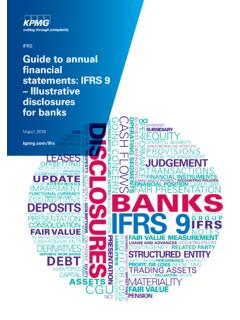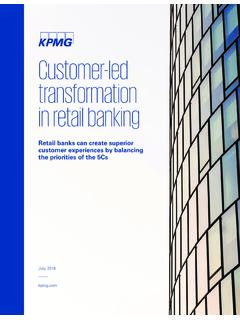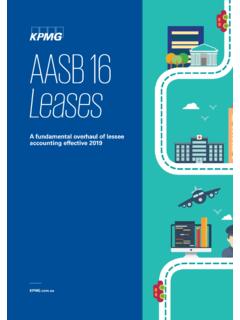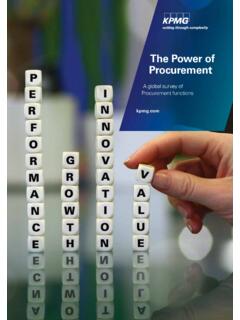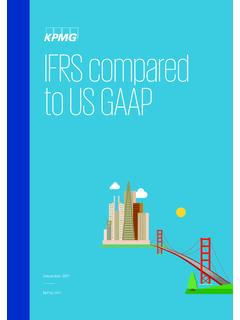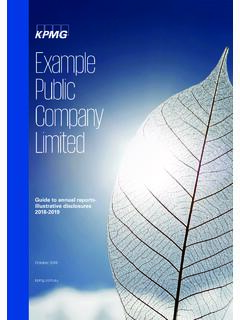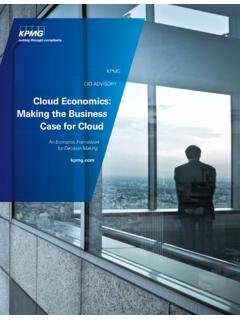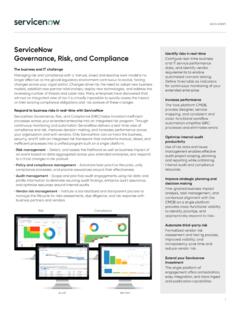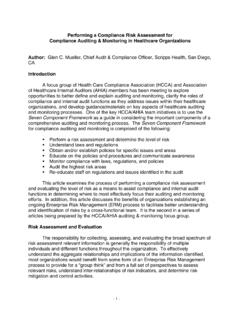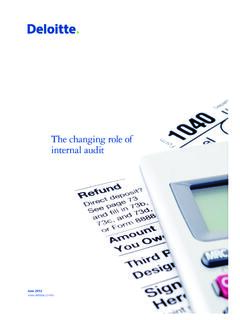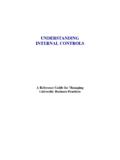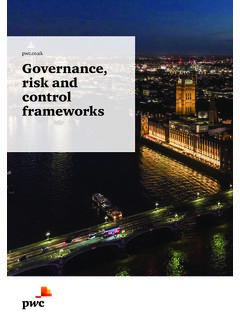Transcription of Internal Audit: Key risk areas 2021 - assets.kpmg
1 Internal audit : Key risk areas | Internal audit : Key risk areas 2021 2020 KPMG Advisory audit functions around the world are continuing to expand their impact and influence within their organizations through the delivery of advisory services as well as assurance around the most important risks to the organization. Starting with the planning and scoping of the annual Internal audit plan, the key question posed to every Chief audit Executive will be to consider: Therefore, we have identified and compiled some areas of focus related to risks which the Internal audit function should consider in developing the Internal audit plan and the prioritization of audit topics for the year 2021. Internal audit : Key risk areas 2021 Are you aware of the risks concerning Internal audit today and in the near future?Key risks for 2021 Without a question, 2020 was defined by the global coronavirus pandemic and a series of unprecedented natural disasters and civil unrests, and is setting a scene for a new business normal for years to come.
2 These new developments are accompanied by emerging risks that Internal audit should take into consideration in its annual plan without neglecting key established risks . As a result, we believe the following risk areas will take the center stage in 2021. 2020 KPMG Advisory resilienceStaff well-being and talent managementCrisis management and planning will have to be updated for the potential for more waves of the coronavirus, not to mention other possible pandemics that follow a similarly rapid contagion audit can review whether the business has carried out reviews to determine how well it is coping with the crisis and whether the business continuity or crisis response plans are fit for purpose, are followed and whether they require updating. Internal audit should also seek evidence of the governance around crisis decision-making and the integrity of data and information reported to crisis ways of working and organizing personnel trend lead towards more flexible working arrangements and greater autonomy by forcing remote working with the outbreak of the pandemic.
3 All businesses should have some degree of skills mapping and forecasting capability to understand and anticipate the organization s human capital requirements. Internal audit should look for evidence that the business understands and is forecasting what skills, competences and attitudes are required to secure its market position and long-term strategic relevance. There is scope here for culture audits, or cultural elements of HR audits, to show how the everyday life of the organization and the behavior of its staff reflect the adopted | Internal audit : Key risk areas 2021 Fraud and the exploitation of operational disruptionThe risk profile will change and fraud risk, in particular, will change significantly after the COVID-19 pandemic. The control framework and monitoring of potential criminal activity may have become weakened due to reduced headcounts and remote working, leaving gaps in fraud detection and creating opportunities for malicious customers and staff.
4 The pandemic also had a significant impact as short-term liquidity risk, which could also lead to a higher fraud risk being the consequence of cost cutting in the control environment to reduce monitoring audit can gain insights into the business s fraud risks by identifying the effects of recent operation disruptions. Internal audit should identify potential fraud risks , during every audit , and evaluate if the established controls that prevent and recognize fraudulent behavior are still in place and operating change: the next crisisInternal audit increasingly recognizes the challenge and risks companies face in achieving their sustainability goals and minimizing their contribution to climate change. Internal audit can assist to establish how well prepared are we for the climate crisis and what are we doing to ensure we are turning it to our advantage rather than contributing to it?
5 Internal audit can examine this area at an operational level too, given its deep view into the processes that are related to and impacted by sustainability, from materials sourcing to transport and logistics and waste | Internal audit : Key risk areas 2021 2020 KPMG Advisory security and data privacy in the expanded work environmentThird-party risk management remains important as organizations choose to outsource their business functions to third-party vendors emphasizing an existing need for contract management. As the pandemic is disrupting the supply chain and business service set-up of many companies, relationships with third parties are changing. Vendor insolvencies have the potential to cause massive disruption and few companies accounted for risk of outsourcing to overseas territories such as India and parts of Southeast Asia and what this means in the event of a global pandemic audit should take a holistic view towards third-party risk management, beyond contract management to assess whether the company has a clear vision and a robust framework to support audit can assess whether the business has paid sufficient attention to the need to remodel supply chains and outsourcing strategies to improve its operational wide-scale shift to homeworking arrangements rapidly increased the vulnerability of organizations to cyber attacks as work laptops are now forced to share home WiFi networks.
6 There is also greater potential for controls and safety measures to soften or be circumvented when employees are unsupervised, as they are often overlooked and ignored to save time. Advancements of technology also increase the sophistication and frequency of cyber security attacks and frauds. Internal audit can offer its view on the extent to which any relaxing or adaptation of controls has increased the risk of data leakage or security breaches. Internal audit should also check whether cyber security awareness is being sufficiently fostered and whether staff training has been updated in light of changes to the working environment and IT audit should improve the organization s understanding of cyber security risks and identify possible mitigation strategies to these risks to determine if cyber risks have been adequately and behavior and Soft ControlsRecent studies have shown that companies with a clear purpose and an explicit set of values are more successful.
7 They instill trust in products from customers and promote comradery among employees. Internal audit should continue to conduct soft control audits to provide assurance over the current culture in the organization and its impact on the effectiveness of the controls set in management: supply chain disruption and vendor solvencyRISKRISKRISK5 | Internal audit : Key risk areas 2021 2020 KPMG Advisory driven riskDigitalization and Intelligent automationRegulatory compliance is driven by ensuring compliance with a number of regulations, both domestically and abroad. Organizations, regardless of industry, are being inundated with new regulatory requirements. These new regulations place growing pressure on executive management and add complexity to the organizational governance and control audit needs to have a strong understanding of the existing regulatory landscape in which the organization operates in order to assess compliance with relevant regulatory laws and audit can make use of benchmarking and good practice examples to effectively implement legislation requirements into strategies and ensure long-term intelligence, Algorithms, Cognitive computing and Robotic process automation (RPA) are among the top technologies that will continue to have a significant impact on the way we conduct business in the future.
8 As digitalization continues to disrupt operations, business processes and business models, it ultimately brings new risks and challenges in this digital age. Internal audit can help to integrate governance, risk management, and controls throughout the automation program lifecycle by assisting organizations through the change management process. Internal audit plays a significant role in developing appropriate governance and control frameworks and providing input to create a company-wide digital transformation strategy. Data management and data & analyticsData collection and management is expanding extreme rapidly. Technological advances provide businesses with the opportunity to enhance productivity and to make smart business decisions. The adoption of data & analytics becomes crucial and it is essential that organizations identify the possibilities and risks of integrating these technological capabilities into their business operations and audit should assist the organization with the creation and implementation of data analytics tools and dashboard reporting that is aligned with business needs.
9 Internal audit plays an important role in developing system-generated exception reporting and automated controls in order to monitor key risk van Loon Internal audit , Risk & compliance Partner +31 6 53 24 93 28 Leah Jin Internal audit ,Risk & compliance +31 6 12 24 28 47 Huck ChuahInternal audit , Risk & compliance +31 6 46 36 60 information contained herein is of a general nature and is not intended to address the circumstances of any particular individual or entity. Although we endeavor to provide accurate and timely information, there can be no guarantee that such information is accurate as of the date it is received or that it will continue to be accurate in the future. No one should act on such information without appropriate professional advice after a thorough examination of the particular situation. 2020 KPMG Advisory , a Dutch limited liability company and a member firm of the KPMG global organization of independent member firms affiliated with KPMG International Limited, a private English company limited by guarantee.
10 All rights reserved.
